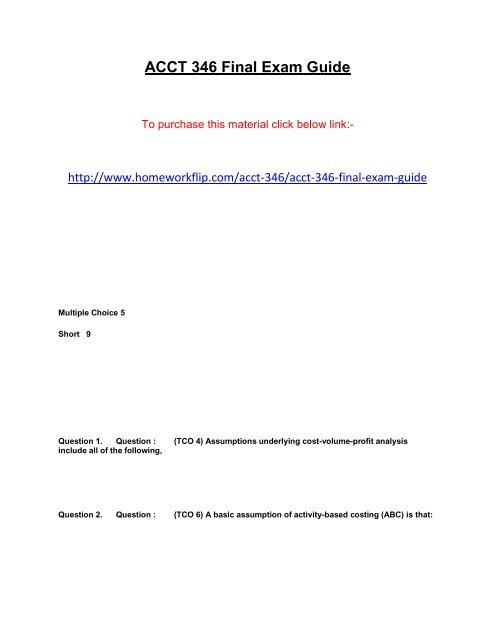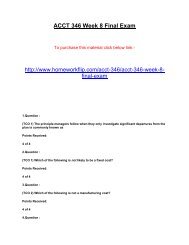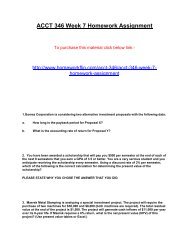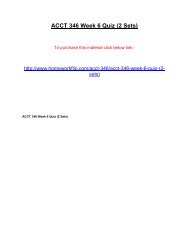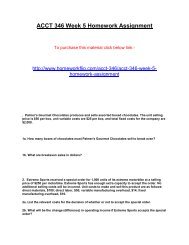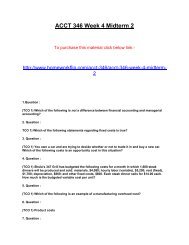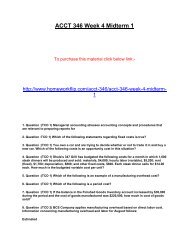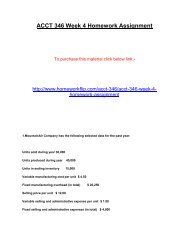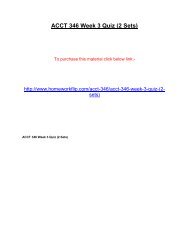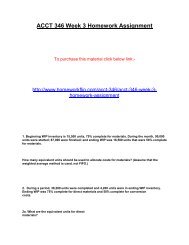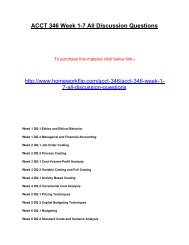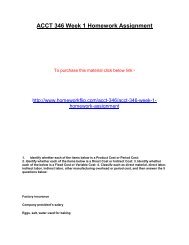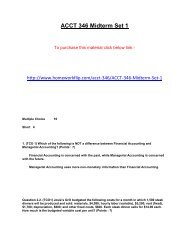ACCT 346 Final Exam Guide
Create successful ePaper yourself
Turn your PDF publications into a flip-book with our unique Google optimized e-Paper software.
<strong>ACCT</strong> <strong>346</strong> <strong>Final</strong> <strong>Exam</strong> <strong>Guide</strong><br />
To purchase this material click below link:-<br />
http://www.homeworkflip.com/acct-<strong>346</strong>/acct-<strong>346</strong>-final-exam-guide<br />
Multiple Choice 5<br />
Short 9<br />
Question 1. Question : (TCO 4) Assumptions underlying cost-volume-profit analysis<br />
include all of the following,<br />
Question 2. Question : (TCO 6) A basic assumption of activity-based costing (ABC) is that:
Question 3. Question : (TCO 2) In a traditional job order cost system, the use of direct labor<br />
on jobs increases:<br />
Question 4. Question : (TCO5) Cost drivers are:<br />
Question 5. Question : (TCO 8) Wood Co. has considerable excess manufacturing capacity.<br />
A special job order's cost sheet includes the following applied manufacturing overhead costs:<br />
Fixed costs: 25,000<br />
Variable costs: 36,000<br />
The fixed costs include a normal $4,500 allocation for in-house design costs, although no inhouse<br />
design will be done. Instead, the job will require the use of external designers costing<br />
$9,250. What is the total amount to be included in the calculation to determine the minimum<br />
acceptable price for the job?<br />
Question 6. Question : (TCO 1) Who are the users of managerial accounting information?<br />
How does their use of accounting information differ from the users of financial accounting<br />
information?<br />
Question 7. Question : (TCO 2) Wolf Co. estimates<br />
that its employees will work 400,000 direct labor hours during the coming year. Total overhead<br />
costs are estimated to be $9,600,000 and direct labor costs are estimated to be $12,500,000. Direct<br />
Labor hours are actually 450,000.
If Wolf Co. allocates overhead based on direct labor HOURS, what is the predetermined overhead<br />
rate?<br />
Question 1. Question : (TCO 3) The Mixing Department is the third department in the MZS<br />
Inc. factory. During January, there were 4,000 units of beginning inventory in the Mixing<br />
Department, and 80,000 units were transferred in from the prior process. There were 8,000 units in<br />
ending inventory. The transferred-in cost in the beginning inventory was $170,000 and there was<br />
$600,000 in transferred-in cost during the month.<br />
What is the cost per equivalent unit for transferred-in cost?<br />
Question 2. Question : (TCO 4) Assume that we are manufacturing a product and assume<br />
that the sales price per unit is $80, the variable cost is $20 per unit, and the fixed cost is $90,000;<br />
a) how many units would we need to sell to break even? b) How many units would we need to sell<br />
to earn a profit of $120,000? c) How many units do we need to sell to double that profit to<br />
$240,000? D) Why didn't the number of units double from Part B to Part C?<br />
Question 3. Question : (TCO 5) Sivan Co. manufactures and sells one product. For the year,<br />
they started with no opening inventory; produced 100,000 units, but only sold 70,000 units. The<br />
selling price per each unit is $60.
The variable costs per unit were:<br />
Direct materials.........................7<br />
Direct Labor .............................6<br />
Variable manufacturing overhead ....5<br />
Variable selling and administrative…6<br />
Fixed costs per year:<br />
Fixed manufacturing Overhead ................$700,000<br />
Fixed Selling and Administrative expenses.. $300,000<br />
(a) Prepare the Income Statement using Absorption Costing.<br />
(b) Prepare the Income Statement using Variable Costing.<br />
Question 4. Question : (TCO 6) At Long Co., electricity cost starts with a minimum fixed<br />
cost, and after that, there is a perfectly variable expense. Using estimated machine hours:<br />
Machine hours<br />
Cost<br />
50,000 $102,000<br />
60,000 $122,000<br />
What is the a) estimated variable cost per machine hour and what is the b) estimated TOTAL fixed<br />
cost?
Question 5. Question : (TCO 7) North Company produces a small part that it uses in the<br />
production of its Product "H". The company's unit product cost for the part, based on a<br />
production of 100,000 parts per year, is as follows:<br />
.................................................Per part ....................Total<br />
parts to the North Company for only $21.25 per part.(it appears to the President of the company<br />
that he could save $2.75 per unit.<br />
100 percent of the traceable or avoidable fixed manufacturing cost is supervisor salaries and<br />
other costs that can be ELIMINATED if the parts are purchased. The decision to buy the parts from<br />
the outside supplier would have no effect on the common fixed costs of the company, and the<br />
space being used to produce the parts would otherwise be idle. Ignore the impact of income taxes<br />
in your calculation.<br />
How much would profits increase or decrease as a result of purchasing the parts from the<br />
outside supplier rather than making them inside the company?<br />
Question 6. Question : (TCO 9) Harry Corp buys equipment for $194,000 that will last for 9<br />
years. The equipment will generate cash flows of $36,000 per year and will have no salvage value<br />
at the end of its life. Ignore taxes. Use 10% required rate of return.<br />
(a) What is the Present Value (PV) of this investment (at 10%)?<br />
(b) What is the NET Present Value (NPV) of this investment Should you buy the equipment if you<br />
need 10%?<br />
(c) What is the Internal Rate of Return (IRR) of this investment?<br />
(d) What is the payback period?
Comments: good!<br />
Question 7. Question : (TCO 10) Tanya Corp sells its products on both credit and cash<br />
basis. Monthly sales are sold 20% for cash, 80% for credit. Credit sales are collected 65% in the<br />
month of sale and 35% the following month. Sales for the first quarter are BUDGETED as follows:<br />
January $300,000; February $200,000; March $300,000.<br />
Compute cash collections budgeted for February. How much cash was collected in the month?


